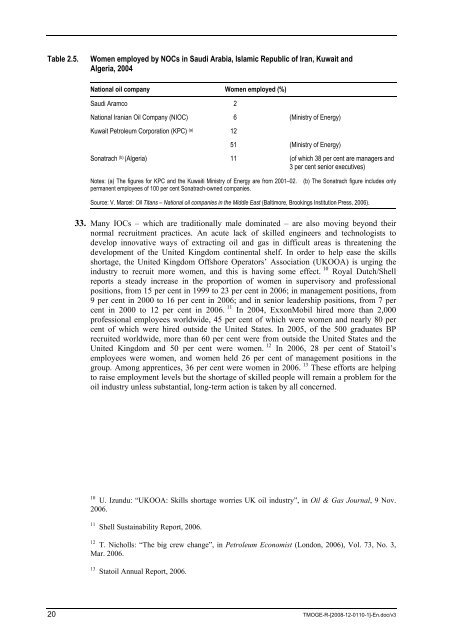wcms_161662
wcms_161662
wcms_161662
Create successful ePaper yourself
Turn your PDF publications into a flip-book with our unique Google optimized e-Paper software.
Table 2.5. Women employed by NOCs in Saudi Arabia, Islamic Republic of Iran, Kuwait and<br />
Algeria, 2004<br />
National oil company Women employed (%)<br />
Saudi Aramco 2<br />
National Iranian Oil Company (NIOC) 6 (Ministry of Energy)<br />
Kuwait Petroleum Corporation (KPC) (a) 12<br />
51 (Ministry of Energy)<br />
Sonatrach (b) (Algeria) 11 (of which 38 per cent are managers and<br />
3 per cent senior executives)<br />
Notes: (a) The figures for KPC and the Kuwaiti Ministry of Energy are from 2001–02. (b) The Sonatrach figure includes only<br />
permanent employees of 100 per cent Sonatrach-owned companies.<br />
Source: V. Marcel: Oil Titans – National oil companies in the Middle East (Baltimore, Brookings Institution Press, 2006).<br />
33. Many IOCs – which are traditionally male dominated – are also moving beyond their<br />
normal recruitment practices. An acute lack of skilled engineers and technologists to<br />
develop innovative ways of extracting oil and gas in difficult areas is threatening the<br />
development of the United Kingdom continental shelf. In order to help ease the skills<br />
shortage, the United Kingdom Offshore Operators’ Association (UKOOA) is urging the<br />
industry to recruit more women, and this is having some effect. 10 Royal Dutch/Shell<br />
reports a steady increase in the proportion of women in supervisory and professional<br />
positions, from 15 per cent in 1999 to 23 per cent in 2006; in management positions, from<br />
9 per cent in 2000 to 16 per cent in 2006; and in senior leadership positions, from 7 per<br />
cent in 2000 to 12 per cent in 2006. 11 In 2004, ExxonMobil hired more than 2,000<br />
professional employees worldwide, 45 per cent of which were women and nearly 80 per<br />
cent of which were hired outside the United States. In 2005, of the 500 graduates BP<br />
recruited worldwide, more than 60 per cent were from outside the United States and the<br />
United Kingdom and 50 per cent were women. 12 In 2006, 28 per cent of Statoil’s<br />
employees were women, and women held 26 per cent of management positions in the<br />
group. Among apprentices, 36 per cent were women in 2006. 13 These efforts are helping<br />
to raise employment levels but the shortage of skilled people will remain a problem for the<br />
oil industry unless substantial, long-term action is taken by all concerned.<br />
10<br />
U. Izundu: “UKOOA: Skills shortage worries UK oil industry”, in Oil & Gas Journal, 9 Nov.<br />
2006.<br />
11 Shell Sustainability Report, 2006.<br />
12<br />
T. Nicholls: “The big crew change”, in Petroleum Economist (London, 2006), Vol. 73, No. 3,<br />
Mar. 2006.<br />
13 Statoil Annual Report, 2006.<br />
20 TMOGE-R-[2008-12-0110-1]-En.doc/v3














